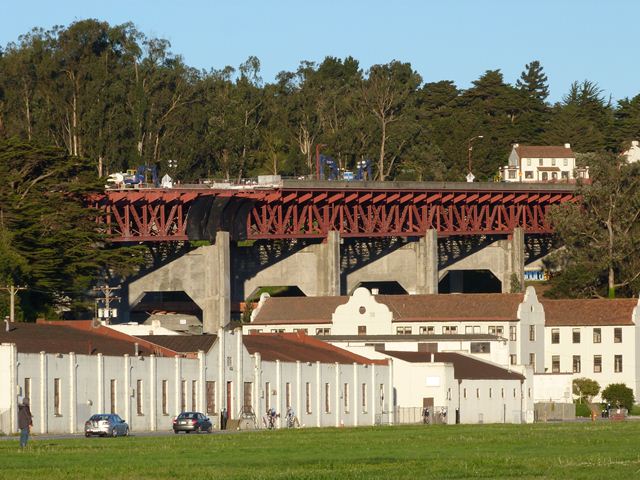We Recommend:
Bach Steel - Experts at historic truss bridge restoration.
Doyle Drive Bridge
Presidio Viaduct

Primary Photographer(s): Nathan Holth
Bridge Documented: April 7, 2013
Doyle Drive (Presidio Parkway) Over Crissy Field Avenue and Valley
San Francisco: San Francisco County, California: United States
Not Available or Not Applicable
134.8 Feet (41.1 Meters)
1,521.0 Feet (463.6 Meters)
60 Feet (18.29 Meters)
8 Main Span(s) and 10 Approach Span(s)
34 0019

View Information About HSR Ratings
Bridge Documentation
This bridge no longer exists!
View Archived National Bridge Inventory Report - Has Additional Details and Evaluation
This historic bridge was demolished and replaced in 2013!
View The Finding of Effect Document For The Replacement Project
View Excerpts From The Finding of Effect Documenting Discussing Bridge Significance
This was a long and impressive viaduct that was highly significant not only for its impressive multi-span deck truss design, but also because it was a part of the approach to the Golden Gate Bridge, the viaduct having been built as part of the same project that constructed the Golden Gate Bridge. Indeed, the viaduct and the contractor who built it is mentioned on the main plaque of the Golden Gate Bridge. The viaduct passed over a setting surrounding by numerous historic buildings. Although not structurally connected to the Golden Gate Bridge, it was part of the approach roadway leading up to the bridge and was designed with art deco details, particularly on the piers, and the deck truss superstructure matched the design of the deck truss approach spans of the Golden Gate Bridge. As such, the bridge was an integral part of the Golden Gate Bridge even if not directly attached to the bridge structure. Despite the fact that the Golden Gate Bridge is one of the most famous and beloved historic bridges in the world, this viaduct portion of the Golden Gate Bridge project has been demolished and replaced with a modern, ugly slab of concrete.
At the time of demolition, the bridge had excellent historic integrity and its trusses, piers, and original paneled concrete railings were all largely unaltered from their original design and materials.
When asked how long the Golden Gate Bridge would last, engineer Joseph Strauss said "Forever!" and "life without end." In contrast, the project website for the demolition of the historic Doyle Drive High Bridge stated that the bridge had reached the end of its useful life. This speaks to two different philosophies, one being that even if "forever" is a stretch, bridges can be maintained and rehabilitated to serve for a very long time, while the other philosophy is that bridges have a short, finite "service life" and so why bother maintaining and rehabilitating bridges? Instead, use them until they wear out and then spend a ton of money demolishing and replacing them. Clearly the latter philosophy was applied to determining the fate of the Doyle Drive Bridge. One can only hope that this philosophy is not extended to the Golden Gate Bridge, built at the same time and with similar construction techniques as the Doyle Drive Bridge. Hopefully the Golden Gate Bridge will not soon be condemned as reaching the end of its useful life alongside a proposal to demolish and replace it with a slab of concrete.
When HistoricBridges.org documented this bridge, demolition had already been started at the eastern end of the viaduct.
![]()
Photo Galleries and Videos: Doyle Drive Bridge
Bridge Photo-Documentation
Original / Full Size PhotosA collection of overview and detail photos. This gallery offers photos in the highest available resolution and file size in a touch-friendly popup viewer.
Alternatively, Browse Without Using Viewer
![]()
Bridge Photo-Documentation
Mobile Optimized PhotosA collection of overview and detail photos. This gallery features data-friendly, fast-loading photos in a touch-friendly popup viewer.
Alternatively, Browse Without Using Viewer
![]()
Golden Gate Bridge in Relationship To The Viaduct
Full Motion VideoThis short video pans from the Golden Gate Bridge to the viaduct to help demonstrate where the two bridges were located in relationship to each other. Streaming video of the bridge. Also includes a higher quality downloadable video for greater clarity or offline viewing.
![]()
Maps and Links: Doyle Drive Bridge
This historic bridge has been demolished. This map is shown for reference purposes only.
Coordinates (Latitude, Longitude):
Search For Additional Bridge Listings:
Bridgehunter.com: View listed bridges within 0.5 miles (0.8 kilometers) of this bridge.
Bridgehunter.com: View listed bridges within 10 miles (16 kilometers) of this bridge.
Additional Maps:
Google Streetview (If Available)
GeoHack (Additional Links and Coordinates)
Apple Maps (Via DuckDuckGo Search)
Apple Maps (Apple devices only)
Android: Open Location In Your Map or GPS App
Flickr Gallery (Find Nearby Photos)
Wikimedia Commons (Find Nearby Photos)
Directions Via Sygic For Android
Directions Via Sygic For iOS and Android Dolphin Browser
USGS National Map (United States Only)
Historical USGS Topo Maps (United States Only)
Historic Aerials (United States Only)
CalTopo Maps (United States Only)


